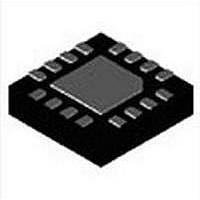MAX17149ETE+ Maxim Integrated Products, MAX17149ETE+ Datasheet - Page 15

MAX17149ETE+
Manufacturer Part Number
MAX17149ETE+
Description
LED Drivers 6-String WLED Driver
Manufacturer
Maxim Integrated Products
Datasheet
1.MAX17129ETE.pdf
(20 pages)
Specifications of MAX17149ETE+
Operating Supply Voltage
3 V to 26 V
Maximum Supply Current
4 mA
Maximum Power Dissipation
1176 mW
Maximum Operating Temperature
+ 85 C
Mounting Style
SMD/SMT
Package / Case
TQFN-16
Minimum Operating Temperature
- 40 C
Lead Free Status / RoHS Status
Lead free / RoHS Compliant
An LED fault open/short is detected after the startup.
When one or more strings fail after the startup, the corre-
sponding current source is disabled. The remaining LED
strings still operate normally.
The devices can tolerate a slight mismatch between LED
strings. When severe mismatches or WLED shorts occur,
the FB_ voltages are uneven because of mismatched
voltage drop across strings. When FB_ voltage is higher
than 8V (typ) after LED turn on, an LED short is detected.
The remaining LED strings can still operate normally.
The devices’ step-up regulator output voltage is regu-
lated according to the minimum FB_ voltages on all
the strings in use. If one or more strings are open, the
respective FB_ pins are pulled to ground. For any FB_
lower than 600mV, the corresponding current source is
disabled. The remaining LED strings can still operate
normally. If all strings in use are open, the devices shut
the step-up regulator down.
The devices perform brightness control with the BRT
input signal. The current in the LEDs follows the duty
cycle and frequency of the BRT signal. The dimming
frequency can be from 0.1kHz to 25kHz.
The full-scale LED current I
connected from ISET to GND and:
The acceptable resistance range for ISET is 44.44kI <
R
current of 45mA > I
The devices include a thermal-protection circuit. When
the junction temperature exceeds T
thermal sensor immediately activates the fault protection,
which shuts down the step-up regulator and all current
sources, allowing the devices to cool down. Once the
devices cool down by approximately 15NC, the ICs start
up automatically. The thermal-overload protection pro-
tects the devices in the event of fault conditions. For con-
tinuous operation, do not exceed the absolute maximum
junction temperature rating of T
ISET
< 200kI, which corresponds to a full-scale LED
LED Short and String Mismatch Protection
Current-Source Fault Protection
I
LED_FS
LED_FS
Open Current-Source Protection
=
Low-Cost, 6-String WLED Drivers with
20mA 100k
> 10mA.
LED_FS
PWM Dimming Control
R
J
ISET
Full-Scale LED Current
Thermal Shutdown
×
= +150NC.
is set by the resistor
J
= +160NC (typ), a
Ω
Quick-PWM Step-Up Converter
All the devices’ designs should be prototyped and tested
prior to production.
External component value choice is primarily dictated
by the output voltage and the maximum load current, as
well as maximum and minimum input voltages. Begin by
selecting an inductor value. Once the inductor is known,
choose the diode and capacitors.
The inductance, peak current rating, series resistance,
and physical size should all be considered when select-
ing an inductor. These factors affect the converter’s oper-
ating mode, efficiency, maximum output load capability,
transient response time, output voltage ripple, and cost.
The maximum output current, input voltage, output
voltage, and switching frequency determine the induc-
tor value. Very high inductance minimizes the current
ripple, and therefore reduces the peak current, which
decreases core losses in the inductor and I
the entire power path. However, large inductor values
also require more energy storage and more turns of wire,
which increase physical size and I
inductor values decrease the physical size but increase
the current ripple and peak current. Finding the best
inductor involves the compromises among circuit effi-
ciency, inductor size, and cost.
In choosing an inductor, the first step is to determine the
operating mode: continuous-conduction mode (CCM)
or discontinuous-conduction mode (DCM). When CCM
mode is chosen, the ripple current and the peak current
of the inductor can be minimized. If a small-size inductor
is required, DCM mode can be chosen. In DCM mode,
the inductor value and size can be minimized but the
inductor ripple current and peak current are higher than
those in CCM. The controller can be stable, but there is a
maximum inductor value requirement to ensure the DCM
operating mode. The equations used here include a con-
stant LIR, which is the ratio of the inductor peak-to-peak
ripple current to the average DC inductor current at the
full-load current. The controller operates in DCM mode
when LIR is higher than 2.0, and it works in CCM mode
when LIR is lower than 2.0. The best trade-off between
inductor size and converter efficiency for step-up regula-
tors generally has an LIR between 0.3 and 0.5. However,
depending on the AC characteristics of the inductor core
material and ratio of inductor resistance to other power-
path resistances, the best LIR can shift up or down. If the
Design Procedure
Inductor Selection
2
R copper losses. Low
2
R losses in
15











